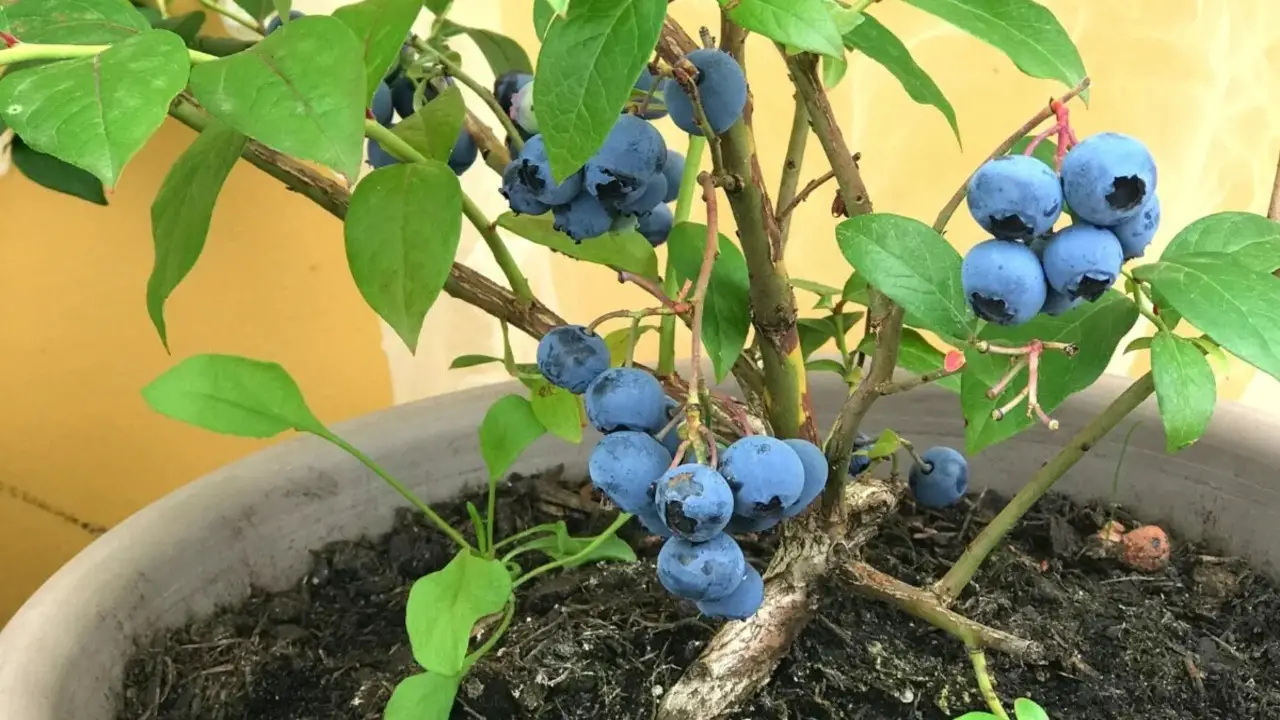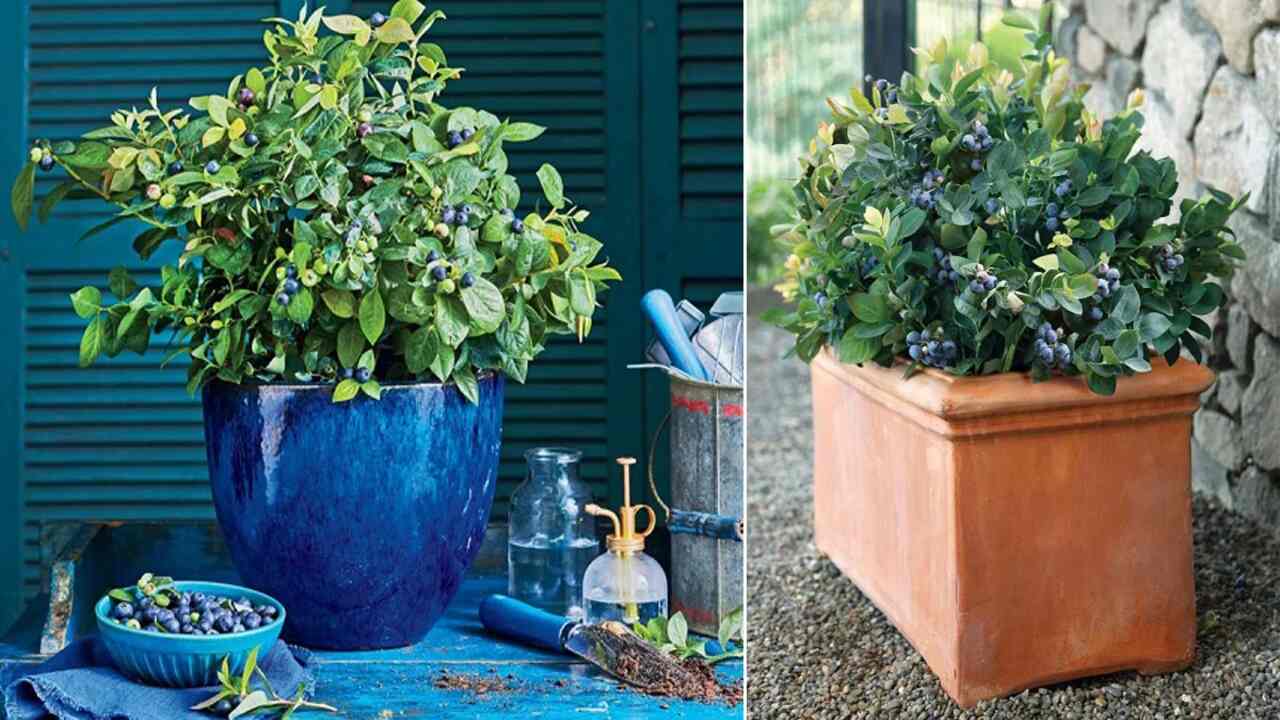Blueberries are one of the most beloved and nutritious fruits in the world, known for their sweet taste and numerous health benefits. While they are traditionally grown in large fields, it is also possible to cultivate them in containers, making them accessible to those with limited space and resources.
However, successfully growing blueberries in containers requires proper knowledge and techniques. Here we will provide a comprehensive guide on how to grow blueberries in containers. From choosing the right container and soil mix to selecting the right variety, we have got you covered.
We will also discuss the factors to consider when selecting blueberry varieties and how to care for your plants throughout the growing season. Additionally, we will touch on common issues that may arise while growing blueberries in containers and how to troubleshoot them.

Advantages Of Container Gardening For Blueberries
Container gardening for blueberries offers several advantages. Firstly, it allows for easy mobility and placement of blueberry plants, making it convenient to rearrange them based on sunlight exposure. Additionally, growing blueberries in containers reduces the risk of soil-borne diseases compared to traditional ground planting.
Containers provide better control over soil pH, ensuring optimal conditions for blueberry growth. Furthermore, container gardening prevents the spread of invasive roots, which can harm other plants. Lastly, container gardening efficiently uses limited space, making it a practical option for those with small gardens or no garden at all.
How To Grow Blueberries In Containers: Step-By-Step Guide

To grow blueberries in containers, choose a large container that can accommodate the blueberry bush. Select a suitable blueberry variety for container gardening and use a well-draining potting mix with added peat moss for optimal growth.
Plant the blueberry bush in the container, making sure to amend the soil as needed. Regular care and maintenance, such as watering, fertilizing, and providing the right sunlight and temperature conditions, are essential for promoting healthy growth. With these steps, you can enjoy the benefits of growing your own delicious and nutritious blueberries in containers. Here is a step-by-step guide on how to grow blueberries in containers:
Choose The Right Container
When growing blueberries in containers, selecting the right container for optimal growth is crucial. Choose a container with a diameter of at least 18 inches, providing enough space for the blueberry’s root system. Look for a container with good drainage holes to prevent waterlogging, as blueberries prefer well-draining soil.
Consider using a fabric container, which allows for optimal root aeration. It’s also important to choose a container made of durable material that can withstand different weather conditions. Ensure the container has sufficient depth to accommodate the blueberry’s root system. Choosing the right container creates an ideal environment for your blueberries to thrive.
Pick The Right Variety

When growing blueberries in containers, picking the right variety is essential. Consider choosing a blueberry variety that is specifically well-suited for container gardening. Look for dwarf or compact blueberry varieties more suitable for smaller spaces.
Additionally, consider the desired flavor and ripening time of the blueberries. Selecting a variety suited for your area’s specific growing conditions is also important. Take the time to research and choose a variety that aligns with your personal preferences and needs. You’ll ensure a successful and fruitful container garden by picking the right blueberry variety.
Use The Right Soil Mix
To grow blueberries in containers, using the right soil mix is crucial. Opt for a well-draining potting mix specifically formulated for container gardening. Enhance the soil’s acidity by adding peat moss, which benefits blueberry plants. Avoid using heavy garden or clay-based soil in containers as they can hinder proper drainage.
It is important to strike a balance between moisture retention and preventing waterlogging. Consider incorporating organic matter like compost to improve the fertility of the soil. Using the appropriate soil mix provides the ideal foundation for your blueberry plants to thrive.
Planting The Blueberry Bush

To ensure proper drainage, place a layer of rocks or broken pottery at the bottom of the container. Position the blueberry bush upright in the center of the container. Fill the container with a prepared soil mix, leaving some space at the top. Gently firm the soil around the base of the blueberry bush.
Thoroughly water the newly planted blueberry bush to settle the soil. Following these steps, you can create an ideal environment for your blueberry plant to thrive and produce sweet and juicy berries. Remember to choose the right container, use the appropriate soil mix, and provide adequate water for the best results.
Watering And Fertilizing
To ensure healthy growth of your blueberries in containers, it is important to provide consistent watering. This will help the plants stay hydrated and thrive. Organic fertilizer is essential to nourish your blueberry plants and promote their growth.
It is crucial to ensure proper container drainage to prevent soggy roots, as this can lead to root rot and other issues. Applying a layer of compost on top of the soil will help retain moisture and provide additional plant nutrients. Lastly, adjusting the soil’s pH level to meet the acidity requirements of blueberries is vital for their overall health and productivity.
Sunlight And Temperature

When growing blueberries in containers, providing them with the right amount of sunlight and maintaining suitable temperatures for optimal growth is essential. Blueberries thrive in full sun, so finding a spot with good exposure is crucial. However, during harsh winter winds, protecting the blueberries by placing them in a sheltered area is important.
You can also consider using bird netting to shield the sweet and juicy berries from hungry birds. Additionally, maintaining the ideal temperature range is vital for their growth. Protect extreme heat or cold conditions to ensure the health of your blueberry plants.
Pruning And Maintenance
To ensure optimal growth, prune blueberry bushes during late winter. This stimulates new growth and helps maintain the shape of the plant. When watering blueberries in containers, it’s important to keep them well-hydrated throughout the growing season.
Consider using a mix of peat moss and potting soil to provide the ideal growing conditions for your blueberry plants. Additionally, choose the right container size that can accommodate the growth of the blueberry plant. To preserve moisture and suppress weed growth, apply mulch such as pine needles or straw around the base of the plant.
Benefits Of Growing Blueberries In Containers

Growing blueberries in containers offers numerous benefits for gardeners. One of the main advantages is that it allows those with limited space, such as apartment dwellers or individuals with small yards, to enjoy fresh and delicious blueberries right at home. Containers also provide better control over soil conditions, allowing for optimal growth and fruit production.
Additionally, growing blueberries in containers makes protecting the plants from pests and diseases easier, as they can be moved indoors or covered when necessary. This method also allows for easy maintenance and harvesting, as the plants are at a convenient height and can be easily accessed. Growing blueberries in containers is a practical and rewarding way to enjoy this nutritious fruit, even in limited gardening spaces.
Factors To Consider When Selecting Blueberry Varieties

When growing blueberries in containers, you must consider the specific variety you choose. Different blueberry varieties have different requirements and characteristics, so selecting the right one for your container garden is crucial. By considering these factors, you can ensure that you select the right blueberry varieties for your container garden and set yourself up for a successful harvest of delicious homegrown blueberries. Here are some factors to consider when choosing blueberry varieties for container gardening:
- Size: Blueberry bushes can vary in size, with some reaching heights of 6 feet or more. For containers, it is best to choose compact or dwarf varieties that will stay smaller and more manageable.
- Chill Hours: Blueberries require a certain number of hours to produce fruit. Make sure to select a variety that is suited for your climate and will receive the appropriate amount of chilling hours.
- Pollination: Some blueberry varieties are self-pollinating, meaning they can produce fruit independently. Others require cross-pollination with another compatible variety. Consider whether you need multiple plants or if a self-pollinating variety would be better suited for your container garden.
- Taste And Harvest Time: Blueberries come in various flavors, from sweet to tart. Different varieties may have varying harvest times, so consider when you would like to enjoy your blueberries and choose varieties accordingly.
How To Successfully Harvest Blueberries From Containers?
Harvesting blueberries from containers can be a rewarding experience, and with the right tips, you can ensure a successful harvest. Following these tips, you can enjoy a bountiful harvest of delicious homegrown blueberries from your containers. Here are some tips to help you get the most out of your container-grown blueberries:
- Timing Is Key: Blueberries are typically ready for harvest in the summer, usually around June or July. Keep an eye on the color of the berries – they should be deep blue and slightly soft to the touch when they are ripe.
- Gentle Handling: When harvesting blueberries, handling them carefully is important to avoid damaging the delicate fruits. Use your fingertips to gently pluck the berries from the stems, being careful not to squeeze or crush them.
- Harvest In Stages: Blueberries don’t all ripen at once, so it’s best to harvest them in stages. Start by picking the ripest berries first, leaving the underripe ones on the plant to continue to mature. This will ensure a steady supply of fresh blueberries throughout the season.
- Don’t Wash Until Ready To Eat: Blueberries have a natural protective coating called bloom, which helps preserve their freshness. It’s best to wait until just before eating or using them before washing them. This will help prevent moisture buildup and extend their shelf life.
Troubleshooting Common Issues When Growing Blueberries In Containers

Growing blueberries in containers can be a rewarding experience, but it’s not without challenges. By promptly addressing these common issues, you can ensure healthy and fruitful blueberry plants in your containers. Here are some tips for troubleshooting common issues that may arise when growing blueberries in containers:
- Lack Of Fruit Production: If your blueberry plant is not producing fruit, it could be due to insufficient pollination. Blueberries are self-fertile but benefit from cross-pollination with another variety. Consider planting multiple blueberry plants or introducing pollinators like bees or butterflies to your garden.
- Poor Soil Drainage: Blueberries require well-draining soil to thrive. If you notice that water is pooling on the surface or your plants are consistently getting waterlogged, it could be a sign of poor drainage. Mix organic matter like compost into the soil to improve drainage and ensure that your containers have proper drainage holes.
- Nutrient Deficiencies: Blueberries have specific nutrient requirements, and deficiencies can affect their growth and productivity. Yellowing leaves with green veins may indicate an iron deficiency, while pale leaves with yellow margins could indicate nitrogen deficiency. Regularly fertilize your plants with a balanced acidic fertilizer formulated for blueberries to prevent nutrient deficiencies.
- Pest Infestation: Common pests affecting blueberries include aphids, spider mites, and fruit flies. If you notice signs of pest damage, such as distorted leaves or small holes in the fruit, take appropriate measures to control the infestation. This may involve using organic insecticides or introducing beneficial insects like ladybugs to your garden.
Conclusion
In conclusion, growing blueberries in containers offers several advantages, including easy maintenance, portability, and control over soil conditions. Following a step-by-step guide on how to grow blueberries in containers and considering factors such as container selection, variety choice, soil mix, and proper care, you can successfully grow blueberries in containers and enjoy the benefits of fresh, homegrown fruit.
Remember to provide adequate sunlight, water, and nutrients, and be vigilant about pruning and maintenance to ensure healthy growth. Additionally, keep an eye out for common issues and troubleshoot them promptly. You can enjoy a bountiful harvest of delicious blueberries from your container garden with proper care and attention.
Frequently Asked Questions
1.Do Blueberries Grow Well In Containers?
Ans: Blueberries can thrive in containers, making them a great option for gardeners with limited space. With the right conditions, container-grown blueberries can produce fruit for years. Remember to use acidic soil, choose a spacious container with proper drainage, and provide regular watering.
2.Can Blueberry Plants Survive Winter In Pots?
Ans: Blueberry plants can indeed survive winter in pots. To ensure their survival, it’s crucial to select a hardy blueberry variety and use a sufficiently large container. Insulating the containers with burlap or bubble wrap, watering sparingly, and placing them in a sheltered location are additional measures to help protect the plants during winter.
3.Do Blueberries Grow Better In Pots Or In The Ground?
Ans: Blueberries can thrive both in pots and in the ground. Growing blueberries in pots offers better soil acidity, moisture, and drainage control. On the other hand, blueberries grown in the ground require well-drained soil with a pH between 4.5 and 5.5. Regardless of the method chosen, proper care and maintenance are crucial for healthy growth.
4.Are There Any Self-Pollinating Blueberries?
Ans: Yes, there are self-pollinating blueberries such as ‘Northblue,’ ‘Northcountry,’ and ‘Sunshine Blue.’ However, cross-pollination between different varieties can improve fruit production and quality. It’s best to consult a local nursery or gardening expert to determine the ideal blueberry variety for your area.
5.Is It Possible To Grow Blueberries In Containers, And How Do You Start?
Ans: Yes, you can successfully grow blueberries in containers. To start, choose a container at least 18 inches in diameter and 12 inches deep. Use an acidic potting mix enriched with organic matter like peat moss or pine needles. Plant the blueberry bush in the container and water regularly, ensuring the soil remains moist but not soggy.
